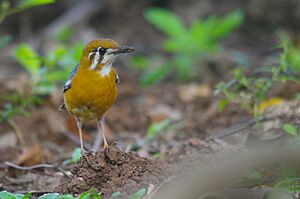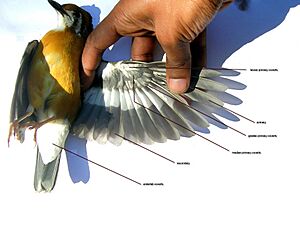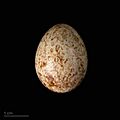Orange-headed thrush facts for kids
The orange-headed thrush (Geokichla citrina) is a beautiful bird that belongs to the thrush family.
It is commonly found in forests and well-wooded areas. These birds live across the Indian Subcontinent and Southeast Asia. Most orange-headed thrushes stay in their homes all year. They prefer shady, damp places. Like many thrushes, they can be quite secretive and hard to spot.
The orange-headed thrush is an omnivore. This means it eats both plants and animals. Its diet includes many different insects, earthworms, and fruit. It builds its nest in trees. Unlike some birds, it does not fly around in large groups.
Male orange-headed thrushes have a bright orange head and belly. Their upper body is a uniform grey. Females and young birds look a bit different. They have browner upper parts instead of grey.
Quick facts for kids Orange-headed thrush |
|
|---|---|
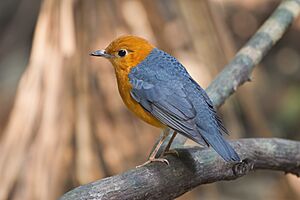 |
|
| Male, ssp. innotata, in Khao Yai National Park, Thailand
|
|
| Conservation status | |
| Scientific classification | |
| Genus: |
Geokichla
|
| Species: |
citrina
|
| Synonyms | |
|
|
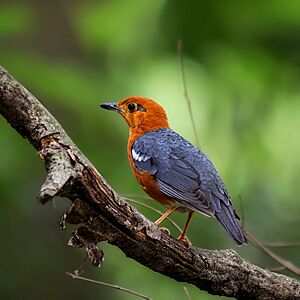
Contents
Bird Basics: What is a Subspecies?
The orange-headed thrush was first described in 1790 by John Latham. He named it Turdus citrinus. The word "citrinus" means "citrine," which is a yellowish-orange color. This name perfectly describes the bird's bright head and belly.
Scientists have found about 12 different types of orange-headed thrushes. These are called subspecies. A subspecies is a group of animals within a species that looks a bit different or lives in a different area. They can still breed with other subspecies. Some scientists think that these different types might even be separate species!
Here are a few examples of these subspecies:
- G. c. citrina: This is the main subspecies. It lives from northern India to eastern Bangladesh. In winter, it flies south to warmer parts of India and Sri Lanka.
- G. c. cyanota: This subspecies mostly lives in southern India. It has a white throat and white on the sides of its face. It also has two black stripes below its eyes.
- G. c. innotata: This type lives in most of Southeast Asia, from southern Burma to southern Vietnam. Males are a brighter orange than the main subspecies.
- G. c. andamensis: This subspecies lives only in the Andaman Islands.
- G. c. albogularis: This one lives only in the Nicobar Islands.
Where Orange-Headed Thrushes Live
The orange-headed thrush lives in many places. Its breeding grounds stretch across the Indian Subcontinent. This includes countries like Bangladesh, India, and Sri Lanka. They also live throughout Southeast Asia, all the way to Java and southern China.
These birds love moist, broadleaved evergreen forests. They prefer areas with medium-sized bushes and ferns. They can also be found in bamboo forests. One subspecies, G. c. cyanota, even lives in big gardens and fruit orchards.
You often find these birds in damp spots. They like areas near streams or in shady ravines. In the Himalayas, they live at heights between 250 and 1830 meters (about 825 to 6040 feet). In other places like Malaysia, Thailand, and Java, they live up to about 1500 meters (5000 feet).
Some subspecies travel to different places for winter. Their winter homes are similar to their breeding forests. However, these areas are usually at lower altitudes.
How to Spot an Orange-Headed Thrush
The orange-headed thrush is about 20.5 to 23.5 centimeters (8.1 to 9.25 inches) long. It weighs between 47 and 60 grams (1.7 to 2.1 ounces).
The adult male of the main subspecies is easy to recognize. It has a completely orange head and belly. Its upper body and wings are a uniform grey. It also has white feathers under its tail. Its beak is slate-colored. Its legs and feet are brown in front and pink or yellowish at the back.
Female orange-headed thrushes look similar to males. But their upper parts are more brownish or olive. Their wings are a warm brown. However, some older females can look almost exactly like the males.
Young birds are dull brown. They have buff-colored streaks on their backs. Their heads and faces have a reddish-brown color. Their wings are grey. Young birds have a brownish beak and brown legs and feet.
The orange and grey colors of this bird make it very unique. It's hard to confuse it with any other bird! Even though subspecies can look different, they all have a special white band under their wings. This helps identify them as orange-headed thrushes.
What Does it Sound Like?
Orange-headed thrushes make several sounds. They might give a soft chuk or tchuk call. Sometimes, they make a screeching teer-teer-teer sound. When flying, they might let out a thin tsee or dzef. However, these birds are usually quiet, especially in winter.
Their song is loud and clear. It's a series of sweet, musical notes. It sounds a bit like the common blackbird's song. But it's more repetitive, like the song thrush. This bird also copies the sounds of other birds. It can imitate bulbuls, babblers, and the common tailorbird. They usually sing from a leafy tree branch. They sing most often in the early morning and late afternoon.
Daily Life and Habits
The orange-headed thrush is a shy and secretive bird. It usually lives alone or in pairs. But it's easier to see than many other thrushes. Sometimes, several birds will gather in one spot outside of breeding season. This happens if there's a lot of food available.
They fly swiftly and silently. If they feel disturbed, they will often sit very still. They wait until the danger has passed.
Reproduction and Nests
Both the male and female orange-headed thrush help build the nest. It's a wide but shallow cup. They make it from twigs, bracken, and small roots. They line it with softer plant materials. These include leaves, moss, and conifer needles. The nest is built up to 4.5 meters (15 feet) high. They choose small trees or bushes. They especially like mango trees and coffee bushes.
The female lays three or four eggs, sometimes five. The eggs are cream-colored. They might also have a pale blue, grey, or green tint. They have pale purple blotches and reddish-brown spots. The parents sit on the eggs for 13 to 14 days until they hatch. The young birds stay in the nest for another 12 days before leaving.
Sometimes, other birds lay their eggs in the thrush's nest. The pied cuckoo is one such bird. It lays a single egg in the thrush's nest. Unlike some cuckoos, the pied cuckoo chick doesn't push the thrush's eggs out. But the thrush's young often don't get enough food. This is because they can't compete with the cuckoo chick for meals. The chestnut-winged cuckoo has also been known to do this.
What Do They Eat?
The orange-headed thrush finds its food on the ground. It prefers to search in dense bushes or other thick cover. They are most active at dawn and dusk. They poke through fallen leaves to find invertebrates. These include insects and their larvae, and spiders. They also eat fruit. In Malaysia, birds that spend the winter there often eat figs.
Status of the Orange-Headed Thrush
The orange-headed thrush lives across a very large area. This area is estimated to be about 2,780,000 square kilometers (about 1,073,000 square miles). Scientists haven't counted all the birds. However, they believe the total number is very large because of its wide range. It is also reported to be common in many places.
The species is not losing its population quickly. It is not declining by more than 30% over ten years. Because of this, the IUCN Red List considers it a species of "Least Concern". This means it is not currently at risk of disappearing.
However, the orange-headed thrush is very popular as a cage-bird in Java. Because of this, its numbers have dropped a lot there. This is due to birds being caught for aviculture (bird keeping). But in other places, like Hong Kong, the bird has actually started living there. It was first seen in Hong Kong in 1956. This happened because the forests there have grown and matured.
Images for kids



